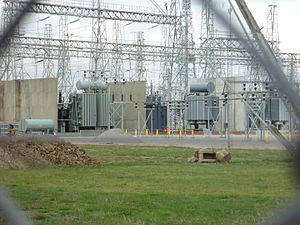
Elements of a substation
A: Primary power lines' side B: Secondary power lines' side
1. Primary power lines 2. Ground wire 3. Overhead lines
4. Transformer for measurement of electric voltage
5. Disconnect switch 6. Circuit breaker
7. Current transformer
8. Lightning arrester
9. Main transformer
10. Control building
11. Security fence
12. Secondary power lines

A 50 Hz electrical substation in Melbourne, Australia. This is showing three of the five 220 kV/66 kV transformers, as well as high-voltage transformer fire barriers, each with a capacity of 150 MVA. This substation is constructed using steel lattice structures to support strain bus wires and apparatus.[1]

A 115 kV to 41.6/12.47 kV 5 MVA 60 Hz substation with circuit switcher, regulators, reclosers and control building at Warren, Minnesota. This substation shows elements of low-profile construction; apparatus is mounted on individual columns.
A substation is a part of an electrical generation, transmission, and distributionsystem. Substations transform voltage from high to low, or the reverse, or perform any of several other important functions. Between the generating station and consumer, electric power may flow through several substations at different voltage levels. A substation may include transformers to change voltage levels between high transmission voltages and lower distribution voltages, or at the interconnection of two different transmission voltages.
Substations may be owned and operated by an electrical utility, or may be owned by a large industrial or commercial customer. Generally substations are unattended, relying on SCADAfor remote supervision and control.
The word substation comes from the days before the distribution system became a grid. As central generation stations became larger, smaller generating plants were converted to distribution stations, receiving their energy supply from a larger plant instead of using their own generators. The first substations were connected to only one power station, where the generators were housed, and were subsidiaries of that power station.

220 kV/110 kV/20 kV station in Germany
Types
Substations may be described by their voltage class, their applications within the power system, the method used to insulate most connections, and by the style and materials of the structures used. These categories are not disjointed; for example, to solve a particular problem, a transmission substation may include significant distribution functions.
Transmission substation
A transmission substation connects two or more transmission lines.[2] The simplest case is where all transmission lines have the same voltage. In such cases, substation contains high-voltage switches that allow lines to be connected or isolated for fault clearance or maintenance. A transmission station may have transformers to convert between two transmission voltages, voltage control/power factor correction devices such as capacitors, reactors or static VAR compensators and equipment such as phase shifting transformers to control power flow between two adjacent power systems.

minimal HV station in Germany
Distribution substation

A distribution substation in Scarborough, Ontario disguised as a house, complete with a driveway, front walk and a mown lawn and shrubs in the front yard. A warning notice can be clearly seen on the "front door". Disguises for substations are common in many cities.[3]
A distribution substation transfers power from the transmission system to the distribution system of an area.[2] It is uneconomical to directly connect electricity consumers to the main transmission network, unless they use large amounts of power, so the distribution station reduces voltage to a level suitable for local distribution.
Switching station
A switching station is a substation without transformers and operating only at a single voltage level. Switching stations are sometimes used as collector and distribution stations. Sometimes they are used for switching the current to back-up lines or for parallelizing circuits in case of failure. An example is the switching stations for the HVDC Inga–Shaba transmission line.
A switching station may also be known as a switchyard, and these are commonly located directly adjacent to or nearby a power station. In this case the generators from the power station supply their power into the yard onto the Generator Bus on one side of the yard, and the transmission lines take their power from a Feeder Bus on the other side of the yard.
An important function performed by a substation is switching, which is the connecting and disconnecting of transmission lines or other components to and from the system. Switching events may be planned or unplanned. A transmission line or other component may need to be de-energized for maintenance or for new construction, for example, adding or removing a transmission line or a transformer. To maintain reliability of supply, companies aim at keeping the system up and running while performing maintenance. All work to be performed, from routine testing to adding entirely new substations, should be done while keeping the whole system running.




No comments:
Post a Comment